|
|
Search for
The Famous Blonger Bros. |
|

October 2007
| 10/6/2007 |
Sole Survivor(s)
Since my post on the LBH forum, Joe's claim to have been at the Little Bighorn the day after Custer's fall has been added to an inglorious list of old-timers with similar stories. This interesting list can be found on wiki: LBH.
-CJ
|
| 10/7/2007 |
The Elite Saloon
The Blonger Bros. Elite saloon has long been storied. Called Denver's flashiest saloon in the Armstrong account, the Elite was next to the Equitable Building, at 1626 Stout St., in 1896.
A new article gives some exravagant detail — and a different name, as well as a slightly different address — to the portrait. Saloon indeed.
Denver Evening Post, October 6, 1896
A MAGNIFICENT SALOON.
Will Be Opened by the Blongers This Evening.
Sam and Lewis Blonger open their magnificent palace saloon at 1628 Stout street, next to the Equitable Building, this evening. It is a veritable palace of luxury—mahogany fixtures and frescoed ceilings at a cost of $8,000—marble floors and an elegant cafe in the rear part of the saloon. In this cafe a fine merchants' lunch will be served from 10 a. m. to 2 p. m. and this will be one of the features of which the genial proprietors will make a specialty. The interior of the new saloon is without doubt one that will be a feast for the eyes of anyone who loves the beautiful. The marble floor will glisten with splendor this evening, and in the language of one of the proprietors, "There isn't an old thng in the house."
This evening the gentlemen in charge will make a special effort to make friends for their new palace—not that they will not always do this, for it is a fact pretty generally known among the boys that Sam and Lew are built on just such plans and specifications. Mat Murray, formerly of the Arcade, Mr. Lockney and Mr. Kelley will be the bartenders in charge, and every one of them is well known in the city as genial, gentlemanly fellows.
Oddly, the Blonger joints often seemed to lack an official name, usually referred to as the Blonger Bros. saloon, or gambling house, Blonger's place, or even just Lew's place.
-CJ
|
| 10/8/2007 |
The Mother Lode
A Thursday night trip to the university library turned into a long weekend as we were flooded by a tidal wave of new Blonger information from the Rocky Mountain News and Denver Evening Post from 1879 to 1899. We knew that if these papers ever made the digital scene that Blonger references would come streaming of out of the woodwork. And our good friend Jeff Smith over at soapysmith.net should be happy as we are, except for the fact that all this new information means a lot more work and analysis. All in all we were able to locate over 250 new articles that contained "Blonger" in the text. Of course some were inconsequential references — sorry, Abbie, but the party you had for your 11th birthday does not make our A list. But many other articles, up to a hundred perhaps, provide new and important information about the state of the bunco business in 1890s Denver, particularly the relationship between the Blonger gang and those of Soapy Smith and Ed Chase.
It's going to take quite a while to organize this material into a usable format and even longer to transcribe the articles. It's doubtful we'll be able to give that treatment to every article, as some of them are quite long. But we will endeavor to post progress reports on the new information, when we can.
I spent a long night last night accumulating the articles and in the midst of my hunting expedition I bagged the article that appears in the blog entry below this one, regarding the opening of the Elite Saloon, and immediately forwarded it to CJ. Minutes later I found "the rest of the story," but, not having the heart to spoil his evening, withheld it until tonight.
The Elite was no doubt a magnificent place, and a vast upgrade from the original Blonger Bros. saloon. A second article, which seems to have been penned by a close personal friend or perhaps the Blongers' mother, is even more effusive with its praise for the new edifice.
Rocky Mountain News, October 25, 1896
...Nowadays men drink like gentlemen and it is little wonder that when they drink they insist on surroundings befitting them. There are gentlemen in Denver who realize this truth. They are the Messrs. Blonger Brothers. They have constructed a temple—a palace—at 1624 Stout street for the accommodation of gentlemen who, for infirmities and for good fellowship, now and then indulge a cup that braces up and cheers. They have named this veritable place The Elite. There is nothing like it anywhere. There is nothing equal to it in richness of material or design or price in any other Western city. It must be seen to be appreciated...
Come to think of it, that paragraph reads very much like a "Saturday Night Live" spoof of James Lipton "Inside the Actors Studio."
Our assumption, based on Fighting the Underworld, was that the Elite was the Blongers' outpost for many years. But the truth was, they overplayed their hand. Either Denver was not ready for a lavish drinking establishment, or the Blongers seriously overspent trying to bolster their respectability. The Elite pulled up lame coming out of the gate. A smattering of new articles tells the sad story:
Rocky Mountain News, February 7, 1897
CLOSED BY ATTACHMENT.
Blonger's saloon was closed yesterday afternoon on a writ of attachment secured by Attorney Parks.
Rocky Mountain News, February 19, 1897
CREDITORS WILL GET LITTLE.
The inventory of Herbert Emerson, assignee of Blonger Bros., filed in the district court yesterday, indicates that there is not much left for the general creditors. The assets consist of the stock, $3,000, against which there is a chattel of $2,500, leaving an equity of $500. The fixtures are entirely covered with chattel. The liabilities are about $13,000, including the $0,500 [sic — perhaps $10,500?] in notes which the chattel mortgages secure.
Rocky Mountain News, March 3, 1897
SOLD UNDER FORECLOSURE.
The saloon and cafe of L. H. and S. H. Blonger, at 1624 Stout street, was sold Monday afternoon by F. W. Parks, under foreclosure, to W. G. Brown, for $3,180.
-SJ
|
| 10/9/2007 |
The California Gang
Early in our research, Forbes Parkhill told us of the California Gang. In Wildest of the West, Parkhill said the gang controlled bunco operations prior to Lou's rise to power. In Mattie Silks, Matt Braun runs with it and creates a whole subplot involving bad blood between Soapy's gang and the Californians.
These new items from the Denver Evening Post and the Rocky Mountain News paint a different picture. The California Gang, in fact, seems to have been a group of female pickpockets led by one May Bigelow, "Queen of the Pickpockets," who came to Denver in 1892. Pockets were generally picked during trysts in the lady's chamber.
What's more, Sam and Lou were their protectors. According to the Post, November 15, 1895, thirteen indictments were handed down, and two arrests made — Bigelow, and Sam, on charges of grand larceny and robbery.
Not that they hadn't tried before. Fines, appealed; warrants issued, but Deputy Tom Clarke could never find them.
In a long article on November 21, it was noted that, that "On many occasions, Lew Blonger has come to her rescue as her ever-ready bondsman."
-CJ
|
| 10/10/2007 |
Soapy Smith & the Blonger Bros.
Of course, Jeff Smith has been going at these newly digitized Post and News articles like a mad dog, just like us. He's found hundreds of new articles for his research.
Just passed along, a Rocky Mountain News "Local Brevity," August 5, 1894.
Chief [of Detectives Leonard] De Lue arrested Tom Cady, Morris Brannick, Louis Cohen and Billy Daly, members of the "Soapy" Smith-Blonger bunco-steering brigade. They intended working the picnics with the shell game, but De Lue's moral crusade interfered. He says he intends to drive the bunco steerers out of the city.
That DeLue had a sense of humor. Twenty-seven years later, DeLue was the man who introduced his old friend Lou Blonger to a young candidate for the office of Denver's district attorney, Philip Van Cise. And after Lou's failed attempt to bribe him, Van Cise would see Lou behind the bars of Cañon City Penitentiary.
But more to the point, we find ourselves increasingly confronted by evidence that in the mid-1890s some bunks in Denver worked for both Soapy and the Blongers. Or they all worked for Smith, including the Blongers. Or they worked for Smith and the Blongers in different senses. Or Smith and the Blongers were partners to some extent.
In any case, there was no evident long-standing animosity between the Smith and Blonger camps, such as they might have been.
There were tensions, of course. Coming up we'll talk about talk of a "war" between the Blonger gang and Ed Chase's men. And of course, it has been suggested that, on the night Soapy and Bascomb assaulted Johnny Hughes, leading to Bascomb's imprisonment, and Soapy's ultimate departure from Denver, the Smith Bros. also paid a call on the Blonger Bros. — though a thoughtful cop is said to have cajoled them into reconsidering their intentions.
But Bascomb didn't seem bitter when he mentioned Sam in his letter from jail, and some of Soapy's men worked with Lou after Soapy's departure.
And then there's this.
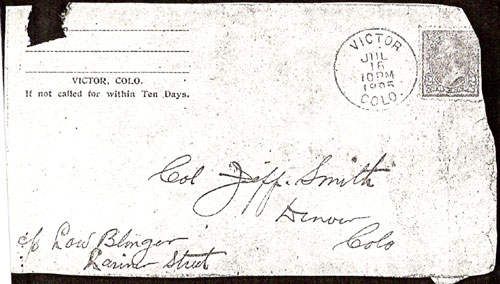
It was easy, in the beginning, to think of "gangs" as groups that must always be in conflict with others of their kind, protecting territory, fighting for turf. It was obviously much more nuanced — more civilized, you might say — than I expected. A lot of money was at stake, and these were tough men, but they seemed to prefer talking to fighting when it came to business. Maybe that's the secret of Lou's long career.
-CJ
|
| 10/15/2007 |
Drinking from the Firehose
That's the situation this week after downloading hundreds of clippings from a new database. They're not all Blonger clips. Many have to do with some of the peripheral characters we've met or general conditions for gambling and bunco in 1890s Denver. We've barely had time to read them as the gathering proceeded at breakneck pace.
Which brings up an interesting philosophical question. Assuming that most historic newspapers will be eventually be digitized, is it better to bide your time waiting for an online index that can be harvested in one fell swoop, rather than painstakingly rolling through reel after reel of microfilm on the off chance that they will contain useful information? If you wait for the newspapers to be digitized, you save an incredible amount of time (which can be put to other good use) and will find a higher percentage of the articles you're seeking; on the other hand, if you'd gone to the film from the start, you might have made the same discoveries years before, and used that information to springboard into some other topic. I stress might because the success of microfilm research is subject to many variables: the quality of the film, the brightness of the bulb, the general ease of use of the microfilm reader, the length of the film rental, the skill of the researcher in picking out certain words or names on sight, and the general stamina of the researcher's backside, eyes, and neck. Especially neck.
So we were lucky this time that the time period we were most interested in, Denver before the turn of the century, became available online. We still need Denver from 1900 to 1924, and a variety of other small outposts around the West. But if we had wished for any time period, this would have been it.
That said, none of the Denver newspapers were able to answer a simple question we've been trying to settle for a few years. Did the Blongers ever live in Dodge City? The answer comes today from, of all places, the U.S. Supreme Court.
Found online, in depositions taken in the case of U.S. v. Atkins, argued before the Supreme Court in 1922, is the testimony of one Joe A. Eckert, a tailor from Leavenworth, Kansas. The case had to do with a land patent granted to a Creek Indian, but that's beside the point. I'm not even sure what the point of Eckert's testimony was. The important part, as far as we are concerned, comes near the end of his testimony, when he was asked where several customers, listed in his sales book for December, 1885, lived:
Q. Where did James H. Kelley live?
A. Old Doc Kelley lived in Dodge City, was Mayor of Dodge City four years. Old Jim Kelley-Harve Kelley, as I called him, he was my best friend.
Q. Where did George Anderson live?
A. Dodge City.
Q. George Reynolds?
A. Dodge City.
Q. Jack Keeler?
A. Dodge City.
Q. Sam Blonger?
A. Dodge City.
So there you have it. Sam, at least, seems to have been part of the sporting crowd in Dodge during its heyday, which lasted until 1886. And where was Lou? According to his own testimony, he was living with Frank Thurmond in southwestern New Mexico. But even if that's true, it wouldn't rule out a trip to visit his brother and the other knights of the green cloth.
-SJ
We've been looking for a definitive Dodge City connection for a long time. Most have suggested Sam and Lou visited earlier in their career, 1878, perhaps, but we'll take 1885.
Sam and Lou were inseparable for many years, from the end of the Civil War, when Sam returned from California, until they parted ways, apparently, after the eventful year of 1882 in Albuquerque. They would not be a duo again, to our knowledge, until they both made Denver their final home around 1888.
So what do we know about those hazy years, 1883 through 1888?
Start with Lou's pension survey, 1887:
Since 83 until the present time here resided with Frank Thurmond at Silver City, Deming and Kingston New Mexico. And here been treated in that time by Dr. Innes, Kingston New Mexico and by Dr. McGuire, of same place present Post Office address Kingston Sierra Co New Mexico
And I further state that from the year 1868 until 1883 I was with my Bro as above stated and under his care and support wholly unable to perform manual labor & support myself. Since I have been with Mr. Thurmond as above stated. I have but partially supported myself, and at present have no employment and am wholly unable to support myself by labor.
So far we have not definitively placed Lou in the Deming area during this time, though it is currently the most plausible scenario.
Other documents indicate Lou was in Denver in August of 1883, signing Joe's request for a pension increase, though this indicates little of substance. Sam spent the year racing horses in Colorado and New Mexico.
Our timeline for 1884 is utterly blank.
In 1885, Simon and Sam are in Aspen, and Sam's wife and child in Denver.
1886 is, again, a blank.
In 1887, Lou filed for his pension from Kingston. In 1888 he showed up in Kingsman, AZ for the murder trial of Kitty Blonger.
So, the Deming area and Dodge City newspapers await, such as they may be. It sounds as though Sam, if he did live in Dodge — the line between living and visiting was pretty fine among gamblers — was there, at most, for part of 1885 through 1888.
The last cattle drive to Dodge was in 1885. Bat Masterson was there in '85, a peace officer. He'd be in Denver too, by 1891. Bill Tilghman was marshal.
-CJ
|
| 10/16/2007 |
Simon's Tax
An article — adjacent to an article about Marshal Milt Yarberry's hanging in Albuquerque — in the Colorado Springs Daily Gazette, February 10, 1883, talks about a new tax on mine profits.
Blonger and Castello, our other misrepresentatives who voted for the bill, were not nominated and elected because of any special fitness to represent the people of Lake county, but simply on the score of political expediency. They are both good fellows socially, and are only the easy victims of bad influences.
-CJ
|
| 10/20/2007 |
More to come from the recent finds as we plow through them. In the meantime...
Lou's Women
Lou weds Emma Loring in 1882, in San Francisco. If they married in January, we can't say where he was living at the time — he claimed to be coming to New Mexico from Texas — but thereafter he is living in Albuquerque, New Mexico.
In September of 1882, Lou is arrested for assaulting Park Van Tassel in a bordello after the Professor says something unseemly to the madam of the house. She is noted as being "Lou's woman."
In 1888, an Arizona prostitute, formerly of Albuquerque, murders Charles Hill as he breaks in to her chamber, where she is busy with another client. Her name, even as stated in documents from her trial in Kingman, is Kate "Kitty" Blonger. Lou arrives shortly in town thereafter, presumably to attend her trial (she is found not guilty).
A few days later, in Albuquerque, sporting woman Mollie Blonger is arrested for running a whorehouse.
This all suggests several things: that Lou was a pimp while in Albuquerque; that Kitty and Mollie Blonger worked for Lou and took his name; that "Lou's woman" may be one of these three women, Emma, Kate or Mollie — or even another as yet unnamed.
Was Emma his woman, whom he then married after the incident in September? How strange would it be to take a man's last name as your own, while prostitutes are running around all over the West carrying your name? Could Sam figure in this as well? Could the prostitutes have taken his surname rather than Lou's? But then, he was town marshal...
-CJ
|
| 10/21/2007 |
Van Cise Project Begins
Today we introduce our campaign to name Denver's proposed detention center for Philip S. Van Cise — the man who put Lo behind bars. Please read more about the Colonel and his campaign against the underworld, or just sign our petition!
Can't Keep A Good Man Down
For those who may doubt the influence Lou carried in Denver politics — he was, after all, never elected to office, and worked mainly as a saloonkeeper and mining capiltalist — we offer this headline. Apparently, Lou's analysis of Col. Van Cise's political future was news even with Lou sitting in the county jail — at Van Cise's invitation...
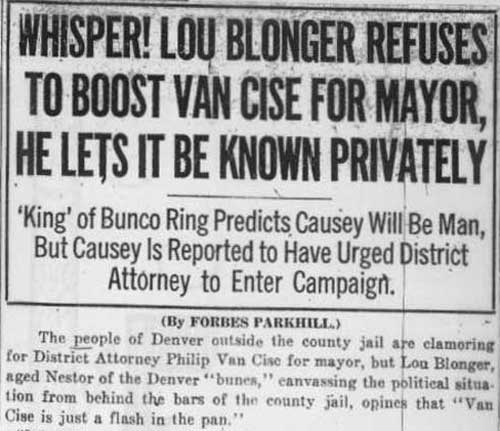
-CJ
|
| 10/26/2007 |
Prettiest Little Spread West — or East — of the Pecos
Yesterday we were lucky enough to have dinner with Merideth Hmura, a fascinating and gracious researcher and author who lives here in Illinois, but hails from Albuquerque.
Merideth's mother was associated for many years with the Viles family, who owned a dude ranch, Mountain View Ranch (below), in the upper Pecos River valley, east of Santa Fe. In time, many photos and documents associated with the ranch came into her mother's possession, and now to Merideth.
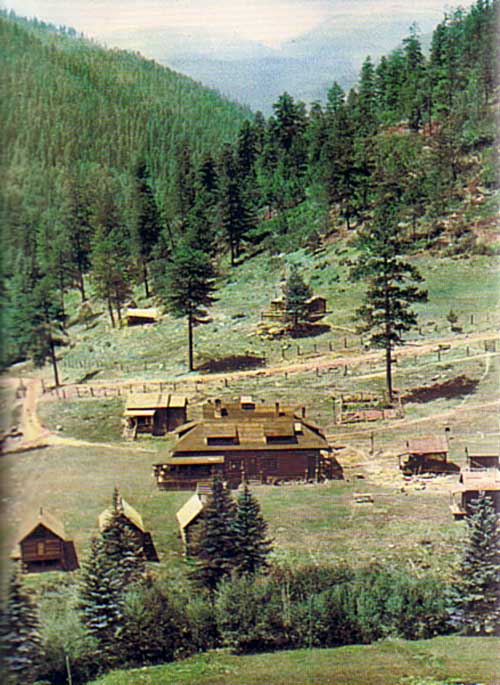

Merideth has undertaken the task of documenting the ranch's history, in such minute detail even a Blonger researcher would be proud. She recently published a book on the subject, Mountain View Ranch, under her own house, Leaning Pine Publishing.
As it happens, the Mountain View Ranch was situated on a plot of land originally owned by our very own Joe Blonger. What's more, Joe was briefly married to Carrie Viles (right) — his only marriage — and the arrangement seems to be have been mysteriously connected to the ownership of this remote, beautifully rugged piece of land. The homestead is represented by the sideways "T" shape below, north of Cowles, NM.

Now — combining Merideth's research, recent data from Rick Van Tassel, and our own timeline:
In the Eighties, Joe lived and worked in Santa Fe, Cerrillos and environs, as a prospector, miner and even as a prison guard.
In March of 1892, he traveled far up the Pecos valley, to a place still barely accessible today, and claimed 160 acres straddling the Pecos River as a homestead — meaning, of course, that the land had to be developed as a domicile rather than as a mining claim.
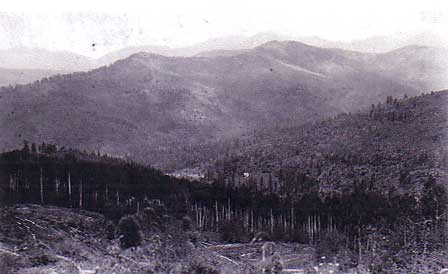
Days later Joe's brothers strike it big on the Forest Queen claim on Ironclad Hill, outside of Cripple Creek.
It is insinuated in March of 1894 that Joe spent 1893 prospecting in Colorado and Nevada.
In 1894 he followed the boomers to Cochiti, north of Albuquerque.
If his land was a homestead, didn't it need to be occupied?
In June of 1895, Charles Viles died. In September, Carrie Viles, purchased Joe's 160 acres. In October, Joe left on a three-week trip to the Picuris and Las Truchas region with a surveying party.
In 1896, Carrie had a small cabin built. (The cabin has since been moved twice, and now currently exists elsewhere in the area.)
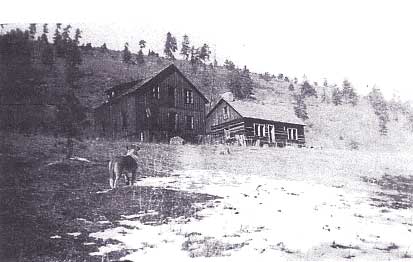
In 1897 Joe is noted as being from Bonanza. He buys property in Santa Fe. Carrie buys an additional piece of land in the Pecos valley.
In January of 1898, Joe finally records his 160 acre homestead.
In August Joe Blonger shoots and kills Alexander Allan, operator of the Bottom Dollar Mine in the Cerrillos Hills, after Allan brandished a gun and threatened to kill Silas Smith with a rock. He is arraigned on charges of murder and with the help of John Andrews, C. A. Scheurich, and J. H. Blain posts bond of $2,500.
Joe's trial is December 22, 1898. He walks. Carrie sells 140 acres.
In 1900, Joe is working around Cerrillos and Santa Fe, and in 1901 he is prospecting northeast of Santa Fe.
Finally, in 1902, Carrie marries Joe.
In 1903, Carrie sells twenty more acres. Joe is in Santa Fe.
In 1904, Carrie marries Benjamin P. Hume.
By 1908, Joe is "retired" in California.
Now we begin the task of figuring out what it all means...
The ranch was bought by the government in the late Seventies, and is now just a meadow.

-CJ
|
October 2007
|
Genealogy - History - Gang - Posse - Evening Review
The Grafters Club - Blonger Bros. Fake Restaurant
|
Copyright Notice: Original material copyright 2003-2021 Scott Johnson and Craig Johnson. Other copyrights may apply to materials found herein. Our primary goal is to reintroduce the Blonger Bros. to the lexicon of the Wild West. We therefore encourage the use of our research, provided due credit is given.
https://www.blongerbros.com
|
|



